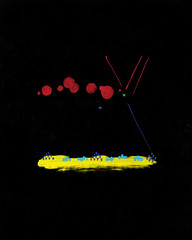Ted Alvin Klaudt - Rapist and IP Moron (updated)
Just a real quick one, because it's a busy day.
This is probably already out there, but I just got wind of this news tidbit, where convicted rapist former South Dakota Rep. Ted Alvin Klaudt (Rapist and IP Moron) has informed various new agencies that... and the only way to do this justice is to quote the article directly:
First of all - Yes, there's such a thing as common-law copyright (sort of). And there's even common-law trademark. But you don't copyright a trademark (*). You certainly don't reserve a copyright on a trademark. It just... it hurts my head to see this kind of usage.
Second, and more importantly - Um.... NO. That's really not how it works. Let's pretend for a minute that the name could even serve as a trademark. I mean, after all, names can be trademarks. You have to be the source of a good or service, though. And the only connection being made in my mind is that Ted Alvin Klaudt is a unique source identifier for the service of inappropriately touching little girls. Or at least that was the service. Now there's a new one: Moronic IP claims. It's sad that he's not a unique provider of that particular service, but as of today he's at the top of the list with a bullet.
Third (really 2a) - Using your name to reference you - even if your name is trademarked (**) for some good or service - is pretty much where the phrase "nominal use" came from. You know, use as a name. So... seriously. Shut up.
So, I'm feeling puckish, and here's my idea. This is the perfect opportunity for a Google Bomb, and an interestingly meta one at that.
Right now, if you do a Google search on the phrase "Rapist and IP Moron" there are zero results:

I'd like to propose a Google Bomb connecting Ted Alvin Klaudt with the phrase Rapist and IP Moron.
Now, normally a Google Bomb of this sort would point to the official homepage of the Bomb-ee or something like that. But Klaudt doesn't have one of those that I could find. So here's the cool, post-modern, self-referential bit. Point the bomb at Google itself. That is, point the bomb at the results page for a search on the phrase "Ted Alvin Klaudt."
If you'll note, I've done the link a few times in this post already. If you click Rapist and IP Moron, it takes you to the Google results page for a search on the phrase "Ted Alvin Klaudt."
[UPDATE - Duh. It's been pointed out to me that Google probably doesn't index its own search result pages. So this won't work as originally planned. I'll figure out a new target soon. I'm thinking something along the lines of this link.]
I don't have a lot of readers, and I don't have a lot of Twitter followers, and I know that probably the worst way to get something to go viral is to say, "hey, I hope this goes viral." I also realize that I'm getting pretty worked up over this and it might not really be worthy of all this agita. But this guy hurts my brain, and I wanna swat him like a bug. So please join in.
A few last points need to be made. The first should be obvious, but this is the internet and there are no guarantees. I am in no way setting up a moral equivalency between the two offenses. Rapist is a big bad; being an IP Moron is just annoying, and possibly works against your self-interest. I recognize the moral gulf between the two and condemn Klaudt for the rapist part much more strongly than the IP Moron part. But he's been a rapist for a long time; it's only today that he came to my attention as both a Rapist and IP Moron. (See how I worked that in there? Clever me.)
The second point is a direct message to Klaudt. If you think you can enforce your "reserv[ation of] a common-law copyright of a trade name," please feel free to sue me. Please note, however, that I have reserved a common-law copyright of a trade name or trademark in my own name, "Ben Manevitz" and any use of my name without my consent - including in court filings, press releases, or even letters telling me to cut it out - will carry with it a penalty of $750,000 per violation. (I figure since I'm not a rapist, my name is worth more than yours out of the box.) Good luck with that suit, Mr. Klaudt, and say hello to your prison husband for me.
--Ben
(*) To my graphic artist readers, I bid you peace. You can, of course, copyright the image or graphic design or whatever that becomes a trademark. And so, litereally and technically, it can be said that you are "copyrighting a trademark." Or more accurately, that a copyright exists in the trademark. (And exactly how that plays out is an interesting question for another day.) But copyright and trademark protect two completely different things, and you can't "reserve a copyright in a trademark" in the sense that this Rapist and IP Moron intends the phrase. ALSO, see (**) re my use of [copyright] as a verb.
(**) I intentionally misuse [trademark] as a verb here; it's a little shout-out to the great and mighty RC.
This is probably already out there, but I just got wind of this news tidbit, where convicted rapist former South Dakota Rep. Ted Alvin Klaudt (Rapist and IP Moron) has informed various new agencies that... and the only way to do this justice is to quote the article directly:
...Klaudt is reserving a common-law copyright of a trade name or trademark for his name. It said no one can use his name without his consent, and anyone who does would owe him $500,000.Okay, so how many ways does this make my eyes bleed?
First of all - Yes, there's such a thing as common-law copyright (sort of). And there's even common-law trademark. But you don't copyright a trademark (*). You certainly don't reserve a copyright on a trademark. It just... it hurts my head to see this kind of usage.
Second, and more importantly - Um.... NO. That's really not how it works. Let's pretend for a minute that the name could even serve as a trademark. I mean, after all, names can be trademarks. You have to be the source of a good or service, though. And the only connection being made in my mind is that Ted Alvin Klaudt is a unique source identifier for the service of inappropriately touching little girls. Or at least that was the service. Now there's a new one: Moronic IP claims. It's sad that he's not a unique provider of that particular service, but as of today he's at the top of the list with a bullet.
Third (really 2a) - Using your name to reference you - even if your name is trademarked (**) for some good or service - is pretty much where the phrase "nominal use" came from. You know, use as a name. So... seriously. Shut up.
So, I'm feeling puckish, and here's my idea. This is the perfect opportunity for a Google Bomb, and an interestingly meta one at that.
Right now, if you do a Google search on the phrase "Rapist and IP Moron" there are zero results:

I'd like to propose a Google Bomb connecting Ted Alvin Klaudt with the phrase Rapist and IP Moron.
Now, normally a Google Bomb of this sort would point to the official homepage of the Bomb-ee or something like that. But Klaudt doesn't have one of those that I could find. So here's the cool, post-modern, self-referential bit. Point the bomb at Google itself. That is, point the bomb at the results page for a search on the phrase "Ted Alvin Klaudt."
If you'll note, I've done the link a few times in this post already. If you click Rapist and IP Moron, it takes you to the Google results page for a search on the phrase "Ted Alvin Klaudt."
[UPDATE - Duh. It's been pointed out to me that Google probably doesn't index its own search result pages. So this won't work as originally planned. I'll figure out a new target soon. I'm thinking something along the lines of this link.]
I don't have a lot of readers, and I don't have a lot of Twitter followers, and I know that probably the worst way to get something to go viral is to say, "hey, I hope this goes viral." I also realize that I'm getting pretty worked up over this and it might not really be worthy of all this agita. But this guy hurts my brain, and I wanna swat him like a bug. So please join in.
A few last points need to be made. The first should be obvious, but this is the internet and there are no guarantees. I am in no way setting up a moral equivalency between the two offenses. Rapist is a big bad; being an IP Moron is just annoying, and possibly works against your self-interest. I recognize the moral gulf between the two and condemn Klaudt for the rapist part much more strongly than the IP Moron part. But he's been a rapist for a long time; it's only today that he came to my attention as both a Rapist and IP Moron. (See how I worked that in there? Clever me.)
The second point is a direct message to Klaudt. If you think you can enforce your "reserv[ation of] a common-law copyright of a trade name," please feel free to sue me. Please note, however, that I have reserved a common-law copyright of a trade name or trademark in my own name, "Ben Manevitz" and any use of my name without my consent - including in court filings, press releases, or even letters telling me to cut it out - will carry with it a penalty of $750,000 per violation. (I figure since I'm not a rapist, my name is worth more than yours out of the box.) Good luck with that suit, Mr. Klaudt, and say hello to your prison husband for me.
--Ben
(*) To my graphic artist readers, I bid you peace. You can, of course, copyright the image or graphic design or whatever that becomes a trademark. And so, litereally and technically, it can be said that you are "copyrighting a trademark." Or more accurately, that a copyright exists in the trademark. (And exactly how that plays out is an interesting question for another day.) But copyright and trademark protect two completely different things, and you can't "reserve a copyright in a trademark" in the sense that this Rapist and IP Moron intends the phrase. ALSO, see (**) re my use of [copyright] as a verb.
(**) I intentionally misuse [trademark] as a verb here; it's a little shout-out to the great and mighty RC.
Labels: Google bomb, misuse of trademark, Ted Alvin Klaudt, trade name, trademark




